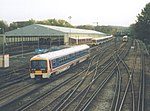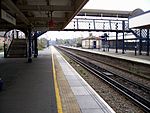Grove Park Nature Reserve is a nature reserve in Grove Park within the London Borough of Lewisham, southeast London, United Kingdom and is bordered by a railway line to the west, residential streets to the east and north, and more woodland and a footpath to the south where the sites entrance is located. The reserve is 4.6 ha (11 acres) in size, being 400 m (440 yd) long north to south, and around 150 m (160 yd) wide, containing woodland in the south and centre and shrubland and meadow in the north where the site narrows to only 50 m (55 yd) in width. Baring Road, the A2212 road with several bus routes is located immediately to the west of the reserve, and the centre of Grove Park including Grove Park railway station is around 750 m (820 yd) to the south. The entrance is at the southern end of the site, from a footpath named Railway Children Walk, part of the South East London Green Chain and is joined with reserve's circular path by a shorter path with a footbridge passing over an unnamed stream which flows westward and empties into a small pond. The nature reserve, which is free to enter is accessed by local primary schools for forest school trips and is also used for dog walking and fruit picking.
Several species of tree grow in the woodland including oak, birch, and ash among others, and the northern meadow area is home to numerous wildflowers such as meadow vetchling, and common vetch. Eurasian blackcap, European green woodpecker, owls, and kestrels, are among the 39 bird species which breed in Grove Park Nature Reserve, and other animals such as bats, grass snakes, hedgehogs, and common lizards also live at the site. Many insect species are seen in the reserve, including nineteen species of butterfly and yellow meadow ant which have made numerous ant hills in the northern meadow. Amphibians including the common frog, smooth newt, and common toad have made their home in the reserve's pond
In the eighteenth century the area that is now Grove Park Nature Reserve and the much of the surrounding area was agricultural fields, the buildings of Burnt Ash Farm were located to the north of the site then by the 1860s several other farm buildings appeared to the west, northeast and southeast. The South Eastern Main Line railway was built through Grove Park in 1865 followed by Grove Park railway station in 1871. In the late nineteenth century, and early twentieth century, tennis courts and residential gardens occupied the area at the southern end of the reserve. From 1894 to 1899, writer Edith Nesbit lived in a large house named Three Gables on Baring Road, her garden backed up to the railway line and overlapped with what is now the southern part of the nature reserve. It is suggested the location inspired her children's book The Railway Children which was published in 1906, and the footpath on the southern side of the reserve was named Railway Children Walk in her memory. During the mid-twentieth century, up to the 1980s, much of the land was used as allotments and was of particular importance during the Dig For Victory campaign during World War II, when there was also an anti-aircraft battery located on the site.
Although the site had been used informally by local residents for recreation for many years it officially became a nature reserve, in 1984, when the Lewisham London Borough Council agreed to manage the area under licence from British Rail, then in 1987 Lewisham Council acquired freehold of the land, following a public enquiry the previous year in which planning permission for housing on land just to the north was granted. An organisation named Friends of Grove Park Nature Reserve was set up, and since 2007, the National Lottery Community Fund awarded the organisation over £30,000, which has paid for new signs, seats, improvements to the entrance and the path, installing bat boxes and a sculpture and several open day activities. The Nature Reserve has won the Green Flag Award several times since 2009. In 2020 Grove Park Nature Reserve and Railway Children Walk were temporarily closed so UK Power Networks could complete works, to maintain the electricity supply network. Although there were delays caused by ground conditions, and the COVID-19 pandemic, the site was opened again in November 2020 after the grassland and pathway was returned to its previous state. In September 2020, it was reported that one of the entry points to Railway Children Walk and Grove Park Nature Reserve was unlawfully closed and locked, and some of the trees had been deliberately damaged. Permission to remove some of the trees and build a trailer park on the land had been applied for but was refused in August 2020, as Lewisham Council had issue with the proposal to erect larger buildings on the land and the plans to cut down a number of trees.
There are proposals for future development of Grove Park Nature Reserve and surrounding green space. Grove Park Neighbourhood Forum has plans for the 7.2 ha (18 acres) of open land, stretching 4.5 km (2.8 mi), from the South Circular in the north, to past Elmstead Woods railway station in the south, including the nature reserve, to be turned into a new larger park. The land covered in the proposal covers, in addition to Grove Park Nature Reserve, Northbrook Park, Hither Green Cemetery, Railway Children Forest Garden, Chinbrook Meadows, Grove Park Cemetery, Sundridge Park Golf Course, Elmstead Woods and several other open areas. Planned development to Grove Park Nature Reserve includes increasing the number of paths that access the site from the outside, and constructing a lookout tower overlooking the railway line. The proposal was submitted to Lewisham Council in 2019 and may stop any new developments being built on the area. The aims of the proposal are to protect biodiversity of threatened species in the area, and to provide opportunities for outdoor learning, recreation and well-being. The new proposed park would follow the railway line, and suggested names include Grove Park Urban National Park, The Railway Children District Park and Railway Children Urban National Park taking the name from the Edith Nesbit novel, said to have been inspired by the location.










